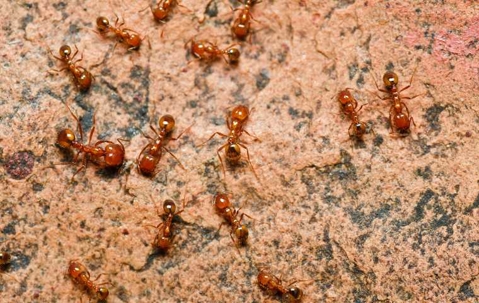Fire ants are small, reddish-brown to reddish-black ants known for their aggressive behavior and painful stings. They are relatively small, with workers typically ranging in size from 1/16 to 1/4 inch (1.6 to 6.4 mm). Fire ants have a distinctive appearance characterized by the following features:
Color: Fire ants can vary in color depending on their species and age. Generally, they have a reddish-brown to reddish-black coloration, with some variations in shades. The reddish tint is more pronounced on their abdomen, while their head and thorax are darker.
Body Structure: Fire ants have a segmented body consisting of three main parts: head, thorax, and abdomen. Their body is covered in fine hairs, giving them a slightly velvety appearance.
Head: The head of a fire ant is slightly wider than the rest of its body and features prominent, elbowed antennae. They have large, well-developed compound eyes and strong mandibles.
Thorax: The thorax is the middle section of the ant's body, and it connects the head to the abdomen. Fire ants have a distinctive hump or bump on the thorax, which is one of their key identifying features.
Abdomen: The abdomen of a fire ant is oval-shaped and typically darker in color than the rest of their body. The stinger is located at the tip of the abdomen. Fire ants use this stinger to inject venom when they sting, causing a burning sensation.
Size: Fire ants exhibit polymorphism, meaning they have different-sized worker ants within a single colony. Workers can range from small, minor workers to larger, major workers. The major workers are typically responsible for defending the colony and are larger than the minor workers.
Legs: Fire ants have six legs, which are relatively long and slender compared to their body size.
The appearance of fire ants can vary slightly depending on their species and geographical location. Additionally, fire ants are known for their painful stings, which can cause allergic reactions in some individuals. Therefore, it's advisable to exercise caution when dealing with fire ants and their nests.
Fire Ant Size
The life cycle of a fire ant includes four main stages: egg, larva, pupa, and adult. The size of each stage can vary depending on factors like species, environmental conditions, and the ant's role within the colony. Here's an overview of the size of each stage in the life cycle of a typical fire ant:
Egg Stage: Fire ant eggs are tiny and nearly microscopic, measuring around 0.5 to 1.0 mm in length. They are usually white and oval-shaped.
Larva Stage: Fire ant larvae are worm-like and undergo several instars (developmental stages). In their early instars, they are very small, typically less than 1 mm in length. As they progress through instars, they grow larger, reaching lengths of up to 5 mm or more.
Pupa Stage: Fire ant pupae are similar in size to the mature adult ants. They are about 3 to 6 mm in length.
Adult Stage: Adult fire ants exhibit size polymorphism within a colony, with different castes (roles) having varying sizes. Here are the approximate sizes for each caste:
Minor Workers: These are the smallest adult ants in the colony, measuring around 1/16 to 1/8 inch (1.6 to 3.2 mm) in length.
Major Workers: Major workers are larger and more robust than minor workers, ranging from 1/8 to 1/4 inch (3.2 to 6.4 mm) in length.
Queens: The queen is the largest ant in the colony, measuring about 1/4 to 3/8 inch (6.4 to 9.5 mm) in length. Queens are typically larger than both minor and major workers.
Males: Male fire ants are the smallest among adults, measuring approximately 1/4 to 5/16 inch (6.4 to 7.9 mm) in length. They are smaller than queens but larger than workers.
The exact size of fire ants at each stage can vary based on species and environmental conditions. Additionally, the worker ants' size can be influenced by their role within the colony, as they exhibit polymorphism to fulfill different tasks such as foraging, defense, and reproduction.
Fire Ant Identification
Fire ants are typically reddish-brown to reddish-black in color. Their appearance can vary somewhat depending on their species, age, and individual factors, but the predominant colors associated with fire ants are within this range. Here is a description of the typical coloration of fire ants:
Body Coloration: Fire ants have a reddish-brown to reddish-black coloration, with some variations in shades. The reddish tint is more pronounced on their abdomen, while their head and thorax are darker. The head and thorax are often darker than the abdomen, giving them a two-toned appearance.
Abdominal Coloration: The abdomen of a fire ant is typically the most visibly reddish part of their body. This red coloration is one of the key characteristics that give them their common name, "fire ants."
Legs and Antennae: The legs and antennae of fire ants are generally lighter in color than the body, often a lighter brown or yellowish-brown.
Variability: There can be some variability in the coloration of fire ants, and the exact shade of red or brown may differ between individuals or even among different colonies of the same species. Additionally, the colors of fire ants can change slightly as they age, molt, or are exposed to different environmental conditions.
While the reddish-brown to reddish-black coloration is a characteristic feature of fire ants, it's essential to consider that variations exist, and the specific appearance of individual ants may differ somewhat within this color range.

